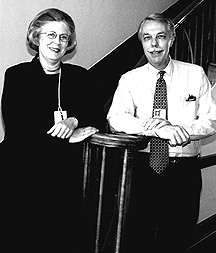"We’re
not just going to sit here in this little corner of the Cloister on the NIH
campus," says Constance
Battle, the new executive director of The
Foundation for the National Institutes of Health. She contemplates making
the rounds—beginning in the fall—to meet with all the NIH institute
and scientific directors.
Battle wants everyone
to know what the Foundation is all about—that it’s an entity created
by Congress solely to further the mission of NIH through private-public partnerships.
This mandate could be
met in many ways: aiding an individual scientist, an institute program, a trans-NIH
initiative, a national consortium that includes an NIH component, or an international
project in which NIH participates. In fact, the Foundation is involved in all
of the above.
As Battle and Foundation
Scientific Director Ted
Colburn, former NIAAA deputy SD, explain it, Foundation support for NIH
steps in where congressional appropriations leave off.
Certain activities or
projects are not embraced in federal NIH funding: "For example, building
a residence for fellows is not something for which NIH receives government appropriations,
nor could NIH ask for such money," Battle said. The Foundation, however,
has two housing projects on its agenda: a guest house for the families of adult
patients on protocols at the Clinical Center and a campus residence to house
students enrolled in the Foundation-supported and Pfizer-funded Clinical
Research Training Program (CRTP).
Meeting other sorts of
funding needs through congressional appropriations may be challenging, Battle
added, citing bureaucratic delays related to procurement and travel and "timing
problems" when congressional monies must be spent within the year for which
the money was appropriated. Money that resides within the Foundation, on the
other hand, may be used and distributed as needed.
Colburn noted that the
Foundation can more smoothly handle cross-NIH training programs, such as the
CRTP and the new Biomedical
Engineering Summer Internship Program (BESIP), another Foundation-supported
program begun this June in collaboration with the Whitaker
Foundation (for a glimpse at the research of one of this summer’s BESIP
students, see "Bounty of Summer Students").
In such programs, he said, students are selected on the basis of academic credentials
and research interest and then select for themselves the institute in which
they would like to work.
He pointed to the biomedical
engineering internship as an "interesting example of a program initiated
by a donor." The Whitaker Foundation suggested to the NIH Foundation that
NIH establish a summer program for undergraduate biomedical engineering students
who had completed their junior year. The Whitaker grant and interested NIH staff
combined to provide housing and training for 10 weeks for the 12 top candidates
in an eligible field of 2,000. Battle and Colburn fully anticipate that the
program will continue.
The need for a training
program for veterinary students, brought to the Foundation’s attention
by an academic institution, suggested another potential project. Also in the
contemplation stage is a role in the Multilateral
Initative on Malaria, an international project to which NIH Director Harold
Varmus has committed the NIH. Such involvement is "prospective" at
the moment—an idea that might materialize in the form of the Foundation’s
serving as a fiscal agent for the initiative, a neutral repository for and disperser
of funds from disparate organizations with a common mission. The Foundation
plays a similar role in the National Coalition
for Health Professional Education in Genetics, a coalition of more than
100 organizations that is co-chaired by NHGRI Director Francis
Collins.
Colburn emphasized that
unlike many foundations, The Foundation for the NIH does not have a "pot
of money" to distribute, but, rather, works to set up partnerships in which
"particular donors can be targeted to particular projects."
"Our primary task,"
Battle said, "is to identify projects, programs, buildings, other needs
at NIH that are not funded—and obtain funds for them. Our purpose, quite
simply, is to help scientists with whatever it would take to enable them to
further their work. They have to know about us so they can approach us,"
Battle said, "and we have to be flexible."
Battle succeeded the
Foundation’s first head, Anne Alexander, in May. According to Colburn,
her application for the position had sailed upon arrival to the top of a rather
tall stack—she was the only seeker of the position who not only had major
organizational and fundraising experience but was also a physician with an impressive
clinical and academic background, a penchant for mentoring, and a prior connection
with NIH.
A professor of pediatrics
at George Washington University in Washington, D.C., Battle says she hopes to
continue to spend several evenings a week teaching first- and second-year medical
students the art of patient interview and physical examination.
